Last Updated on October 10, 2023
Let’s see what the children should know in Deutsch in German primary school, what books can be used for additional work, what written fonts there are. In this topic, grades 1 and 2.
Deutsch in primary schools Grades 3 and 4.
An introductory topic for primary school with navigation
Education system in Baden-Württemberg
Secondary school in Berlin – Brandenburg
Primary school. Office supplies and all for school
A non-speaking child. Part 1. Norm and problems
Bilingual children
Exercise book for grades 1 and 2
Educational textbooks’ sets
The approved textbooks are different in each land.
For example, Zebra, on which we (Ba-Wü) were studied, is not on the list in Bavaria. And the Bavarian Piri is absent in Bremen. A specific set is selected by each school from an approved list at a school conference. However, teachers still have the opportunity to take other textbooks additionally, and some manage to completely ignore the textbook.
Most modern kits consist of a textbook, a reading book, writing book. Additionally, there may be books for weak students. It can be called in different ways: Sprachbuch, Lesebuch, Arbeitsheft, Schülerbuch, etc. We look at the descriptions of the kits from the publisher. Take the Zebra set, for example.
Zebra set: link*:
- “balloon” is the main student’s book,
- “rocket” is for the development of speech,
- “suitcase” is an additional one for theory and reading,
- “a balloon with a rocket” on one cover is an additional training book,
- “scooter” is additional exercises,
- “zebra with a book” is a book for reading.
*The links in this post are affiliated, but this does not affect the opinion of the author. New book’s prices are the same in all stores in Germany
In my opinion, this is a strong set, you can take it for additional work at home.
My second son has a Karibu set for speech therapy schools. It supports the gesture method (more on it below) and spend a lot of time to the sound-letter correlation. I would say these books are not suitable for additional work, at least grade 1.
Some sets support one method or another. Therefore, before buying something on your own, read the description on the publisher’s website. For example, there is a well-known method from Mildenberger*, in which syllables are colored in different colors.
What can you buy for additional work at home
You may have such a problem that simple letters have been studied in great detail and very slowly. And then they jumped: quick-quick all other letters and the children already must read complex words. But your child need more materials to practice simple words.
Fibel (ABC book) is suitable, but there is also this problem: they also sit on A-M-O-N for a loooong time, then they accelerate too much. Fibel is included with each set.
I can definitely recommend the following exercise books. Both series are very helpful for ridiculous money: Libelle* and Lies mal*. The author of the last set also has Rechtschreiben* (exercises for writing rules), which are very useful in the following classes. Klett has a similar set, but I haven’t tried it: Anoki lesen*.
When you get to the sentence level, I highly recommend going to the city library. This should be done much earlier, but at this stage it is necessary. There is a huge selection of books for all levels. Choose 1 class, the desired topic. Popular science books for preschoolers with a minimum of text (like WWW) are also very well suited.
To help you understand the level of the book faster, look for Antolin 1kl. or Antolin 2kl. In our library, it is indicated on the spine of the book. Antolin is a readers club. Maybe your class takes part there.
Deutsch in the First grade
The first grade is devoted to the study of letters and the beginning of reading and writing. By the end of the year, they read words, someone comes up with sentences. They write words and simple sentences. They also give words for memorization in different forms (“dictation from a bank”, memo cards, etc.). These words calls Lernwörter. Only Lernwörter must be written without errors.
There are several methods of teaching reading.
- Classic: we study letters, put them into syllables, syllables into words.
- From writing to reading: we study letters, we immediately write words how we hear the, looking at the picture-letter table. Then we start reading. The method is complicate. I am skeptical about it, but it works with experienced teachers.
- Gestures. This method is more related to speech therapy schools, but it is also used in regular schools (our friends have this). In short: children memorize gestures for each letter. But not the ones used by the deaf. These gestures resemble the writing of letters. For example, m is three fingers attached to the lips (first photo). Letter A is the second photo. There is no general German system, there are a couple of more or less established systems. But each school defines its own. Strong children do not need it, but it really helps the weak.

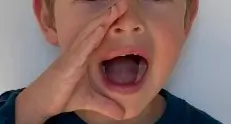
Whatever method your teacher chooses, the picture-letter table must be learned quickly, this will greatly help the child.
Written fonts
Grundschrift
With an older child, I was lucky to be among the experimental classes for the Grundschrift (semi-print font). Unfortunately, the Minister of culture Ba-Wü closed the experiment. Like, children have to struggle to learn a beautiful written font. The lady remained in the 19th century and obviously has zero experience with children. Many children in secondary school switch to print or semi-print, and many older children generally use only computers. For some children classic fonts are unnecessary torture.
Our teacher was fined for trying to object. Unfortunately, this is typical for Germany: the boss’s opinion is sacred, he is always right, even when he is wrong.
So if your child writes very badly in grade 5, offer him writing exercise book in Grundschrift. Perhaps this will save the situation. Tinto, Deutsch plus, Kleeblatt and by Peter Wachendorf are good, others I didn’t check.
The new Grundschrift has been tested since 2011. The letters are connected only when there is a connection, that is, only with a “tail”. Here we have m – it has a “tail”, so the next letter is connected. But s, it is without a “tail” and is written from the other end, so it is written with a gap, without a connection, both in front and behind. The appearance of the letters is very close to the printed font. That is, having studied only the printed letters, the children cheerfully simply begin to connect them. I observed how I write myself as adult, and realized that, in fact, I write this way. And “beatifully font” from primary school is long forgotten.
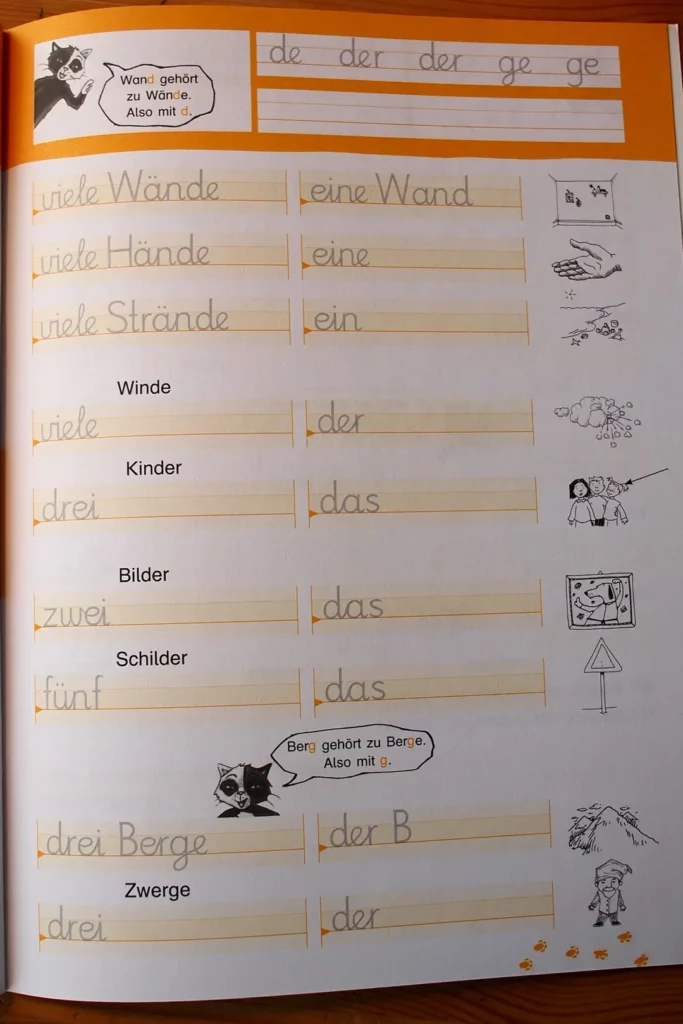
Common fonts
I’ll tell you a little about common school fonts. You need to know about fonts in your school if you buy some exercises book with a written font, for example, for home additional work.
There are several school fonts in Germany. Pictures from Wikipedia.
Historically first – Latin (Lateinische Ausgangsschrift, LA). This font was accepted in the Federal Republic of Germany and replaced the Gothic italics – an old font with curls. In the modern version it looks like this:
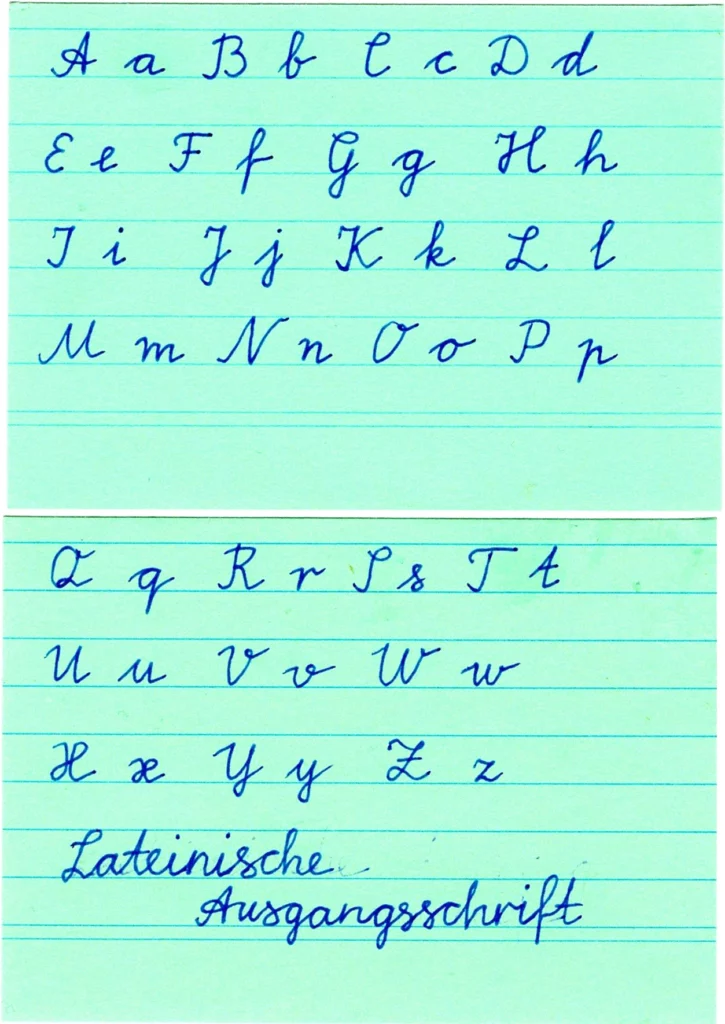
In the GDR, a rather similar one was accepted – Schulausgangsschrift (SAS).
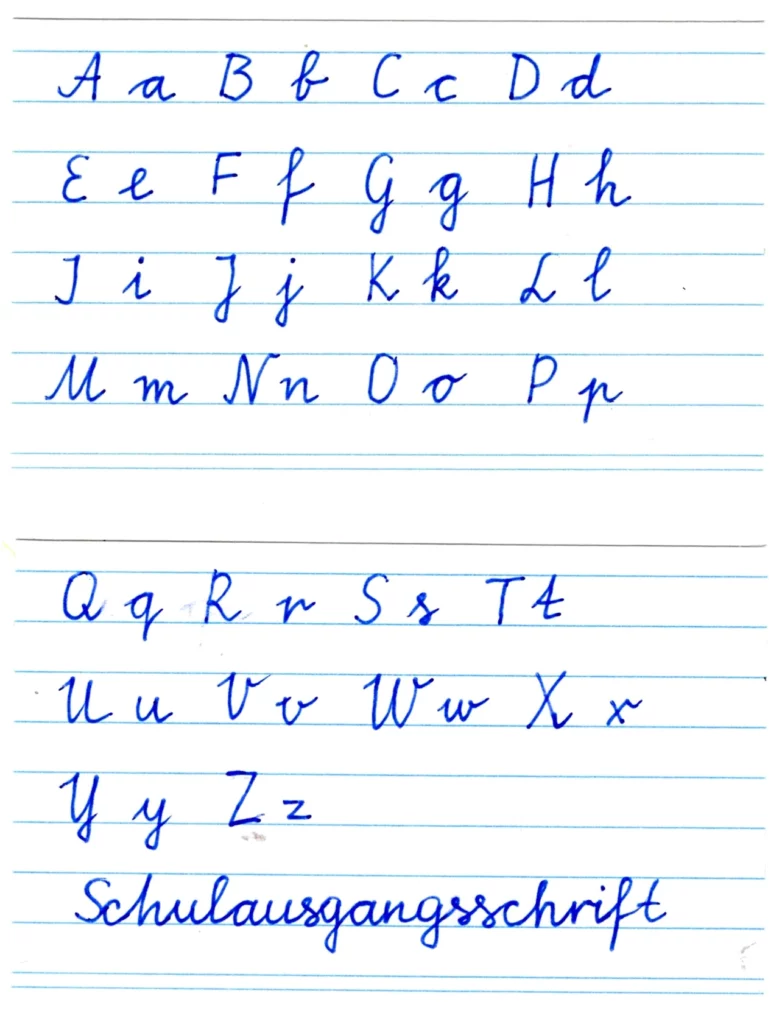
Vereinfachte Ausgangsschrift (VA) – it is a “simplified” Latin script that has been adopted to make life easier for schoolchildren. I would say that Latin is better then. This one turns out to be unreadable.

Each federal state has a law which determines which fonts can be chosen by the state schools. In some lands, there is only one font (as “lucky” Saxe-Anhalt and Schleswig-Holstein – they have a Vereinfachte Ausgangsschrift). Each school decides at the school conference which font it uses. If a child moves from school to school, he has the right to write as he has learned.
Deutsch in the Second grade
The end of the first grade and the beginning of the second are all about speeding up reading and numeracy skills. “Agreements” are issued for 10-15 minutes daily reading. Parents sign them every time. A small toy or book is presented to hard-working readers.
In the second grade, children already write “stories” from pictures on half or almost a whole A4 sheet. Errors have not been fixed yet.
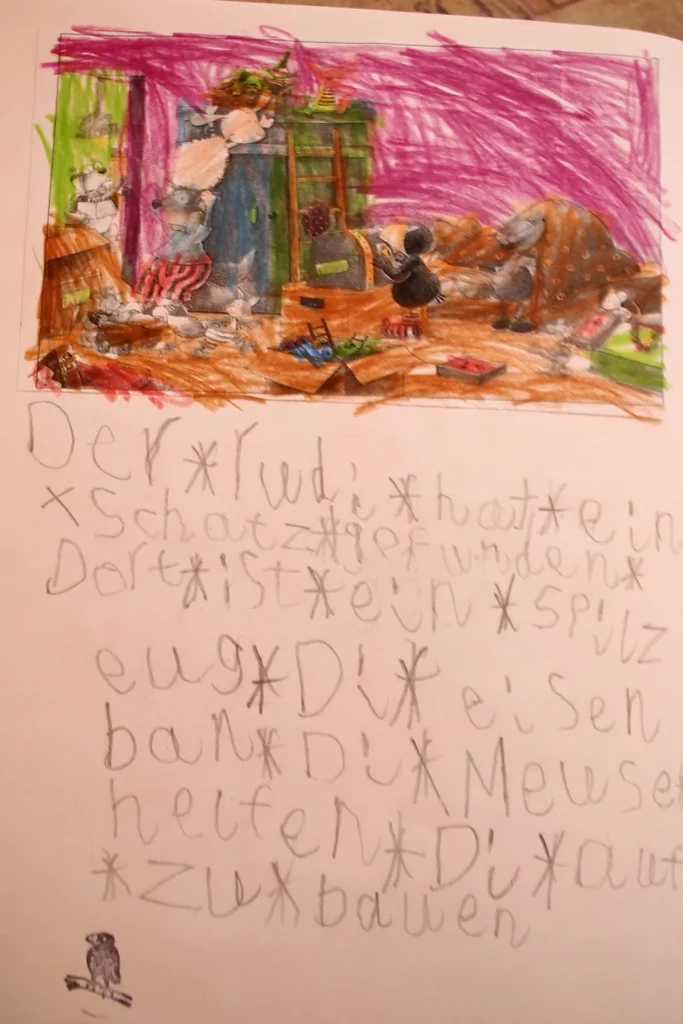

The main grammatical topic of grade 2 is the capital letter in nouns.
Sometimes children learn by heart, also very little: one day one quatrain, another – the next, and only on the third or fourth day the whole poem. They tell at will.
They make presentations from the second grade. There was a big theme “Animals”. It was necessary to tell very briefly about some animal and make a poster. It was possible to prepare both as a group and individually.
Further – German in the 3. and 4. grade.
Do you enjoy the site without cookies and maybe without ads? This means that I work for you at my own expense.
Perhaps you would like to support my work here.
Or Cookie settings change: round sign bottom left

